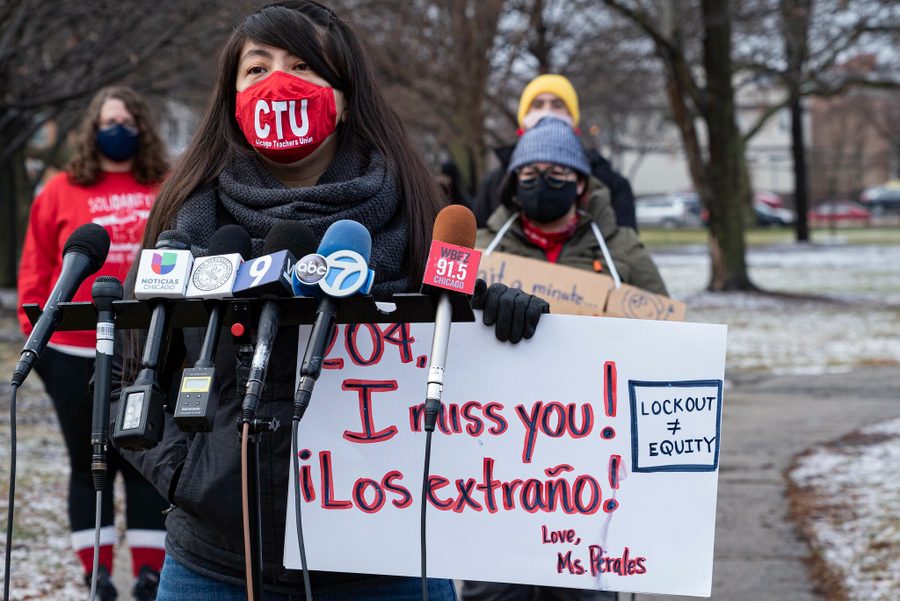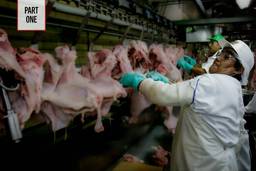How Chicago Teachers Won a Safer Reopening
The Chicago Teachers Union (CTU) has reached the end of a bitter struggle with Mayor Lori Lightfoot over reopening during the pandemic.
Catherine Henderson

Linda Perales has spent the past year in the crossfire of the debate around reopening schools. As a special education cluster teacher in Chicago Public Schools (CPS), she’s felt unsafe, confused and frustrated. But as the dust settles, she emphasizes that she couldn’t have done it without the solidarity of the Chicago Teachers Union (CTU) and her school community.
On April 19, following negotiations between CTU and CPS over high school reopening, Chicago high school students returned to classrooms for the first time in over a year. The union has won key demands around Covid-19 safety precautions, reaching an agreement that includes the promise of a district-wide vaccination plan for students and families in communities that were hit hardest by the coronavirus, as well as options to continue working from home for educators with health risks.
Throughout the pandemic, the CTU has made community resources central to its demands for reopening, using its bargaining power to advocate for students and parents.
“We’re truly a social justice union in everything we do,” Perales says.
In Washington D.C., New York City and Los Angeles, teachers unions have played a major role in ironing out the details of reopening, winning guarantees like regular Covid-19 testing and shorter workdays. In Chicago, where Mayor Lori Lightfoot and her appointed school board have clashed with the CTU, the fight over reopening elementary schools could have resulted in a strike.
But going into the new round of negotiations, the CTU came armed with an essential win from the governor’s office. On April 2, Illinois Gov. J.B. Pritzker signed a bill that restored bargaining rights for the union on a wide range of issues, including class sizes and working conditions. The bill repealed the 1995 Chicago School Reform Amendatory Act, which gave former Mayor Richard M. Daley control over the school district and restricted what the union could bargain over.
Under the act, teachers technically could only strike over economic factors like salaries, but the CTU has still made other policies a central part of its proposals. During the 2012 strike, the union pushed to change teacher evaluations and health insurance, and in 2019, teachers advocated for an even broader set of demands from more support staff in schools to housing guarantees for lower-paid support staffers and homeless students.
But the question of whether teachers could legally push for these broader demands remained— in the winter, when the union told teachers to prepare for the picket lines, CTU President Jesse Sharkey noted that the union could face “legal repercussions” if a strike occurred. Now, it is clear that this is within the union’s legal rights.
CTU President Jesse Sharkey said in a statement:
“With the signing of this bill, we now at last bargain from a level playing field — with the ability to at last reject the chronic classroom overcrowding, incompetent and wasteful third party contracting, and the desperate shortage of school nurses, social workers, counselors and other chronic staffing needs that have plagued our schools for years.”
Alyssa Rodriguez, a social worker in CPS, was part of the CTU’s bargaining team for high school reopening. Though the union’s goals remained the same, she describes the legislation as “a game changer,” with the knowledge that the union was acting within its bargaining rights.
“It gave new hope that we were going to be able to really hammer things down,” Rodriguez says. “Before, it was kind of that gray area of could you get away with it?”
Perales says she hopes the changes will result in fewer teacher strikes. But at least as reopening unfolds, it could also mean constantly negotiating with the city about safety conditions, if the union is responsible for every element of the classroom.
At the bargaining table, Rodriguez describes how district administrators have failed to bring teacher voices into their plans. A lawyer can say that schools will give health screenings and maintain social distancing, but teachers have to enforce these unrealistic promises. “Like have you seen a child?” she says. “I love my students, but they’re also gross.”
Now that educators are working in-person, Rodriguez says the reality of reopening is “not pretty.” Both Rodriguez and Perales were vaccinated in February by seeking appointments on their own, not through CPS.
Perales says she wouldn’t feel safe in the classroom without the vaccine. She struggles to enforce social distancing and mask wearing, especially with her students who are nonverbal.
Her students also need consistency, and the hybrid schedule disrupts that. Perales adds that she hasn’t received any support to figure out teaching both online and in-person students. Navigating a hybrid classroom is another element of what reopening will look like that is absent from the newest agreement.
“It just keeps getting harder and harder,” Perales says. “Sometimes it feels unbearable and makes me question, like oh my god, do I still want to be a teacher?”
It’s been a brutal year, but Perales emphasizes the support of her fellow teachers and parents. When she was locked out of her classroom in February, parents also refused to log their students into class in solidarity with her. With every agonizing decision, she says the union has made her feel informed and supported. “I don’t think I could have gotten through all of this without CTU.”
Catherine Henderson is an editorial intern for In These Times and a master’s student at Northwestern University. You can reach her on twitter at @Caity_ Henderson.





